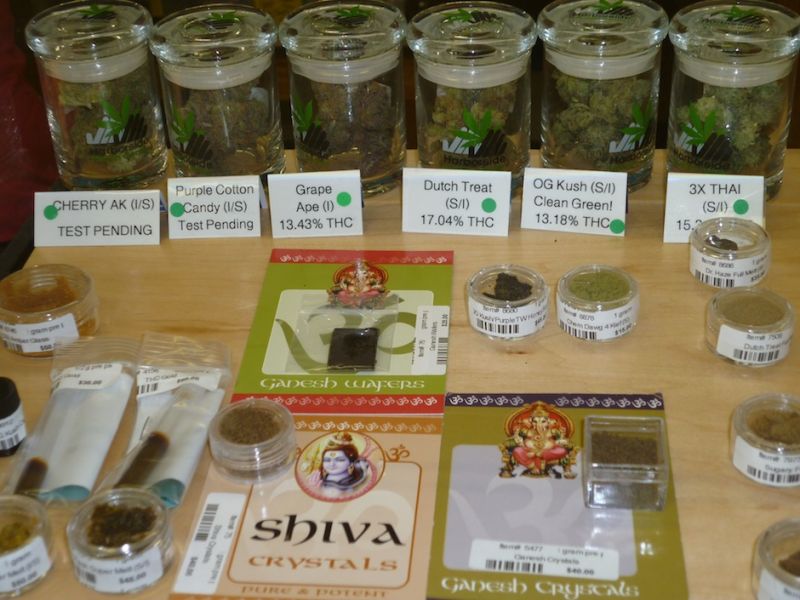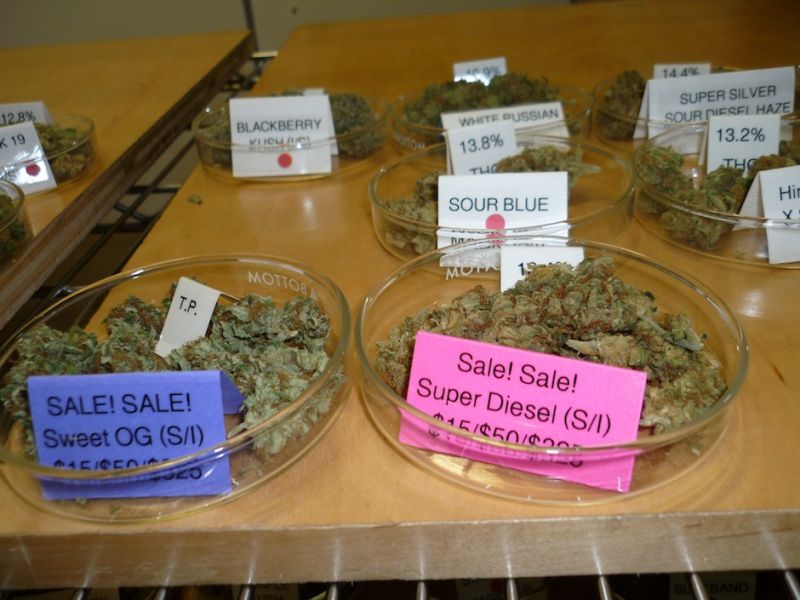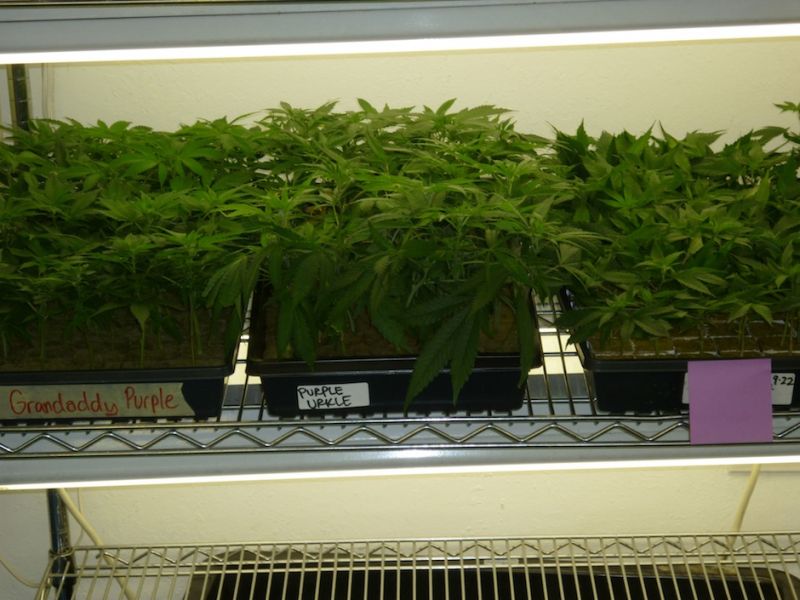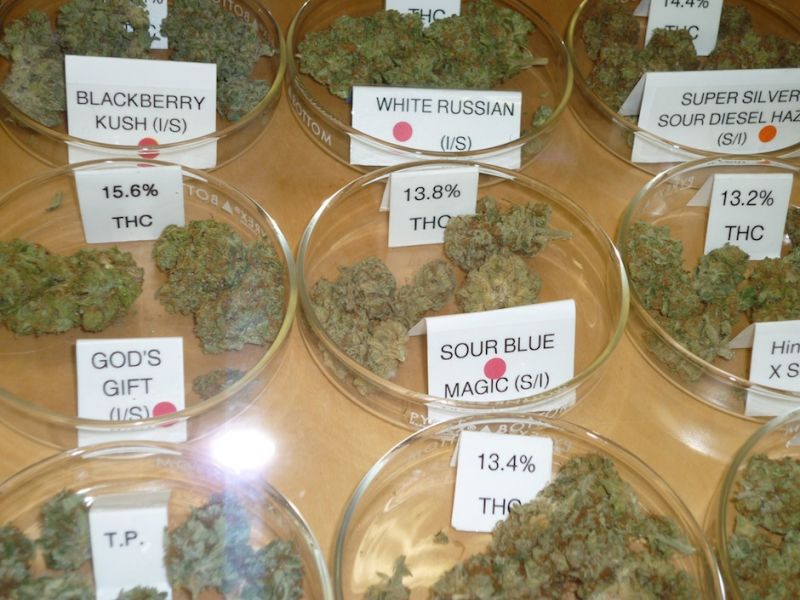 Over the past generation, an informal alliance of activists, cultivators, entrepreneurs and medical professionals has struggled to redefine how the United States views the cannabis plant. Victories at state and municipal levels have created a new field of medicinal treatment for a wide variety of ailments in California and other mostly western states. Medical marijuana marks the starkest point in the divide between an industrial model of healthcare and a millennia-long tradition of herbal self-treatment—because nowhere else has the federal government been so intransigent.
Over the past generation, an informal alliance of activists, cultivators, entrepreneurs and medical professionals has struggled to redefine how the United States views the cannabis plant. Victories at state and municipal levels have created a new field of medicinal treatment for a wide variety of ailments in California and other mostly western states. Medical marijuana marks the starkest point in the divide between an industrial model of healthcare and a millennia-long tradition of herbal self-treatment—because nowhere else has the federal government been so intransigent.
On Jan. 22, the US Court of Appeals for the DC Circuit issued a ruling in a medical marijuana reclassification case, Americans for Safe Access v. Drug Enforcement Administration. The case was brought after the DEA turned down an administrative petition seeking to have cannabis moved from "Schedule 1"—the most restrictive category of controlled substances, that for drugs with no medical use. In a 2-1 decision, the court agreed with the government's assertion that "adequate and well-controlled studies" on cannabis’ medical efficacy do not exist.
This is something of a Catch-22, since the National Institutes of Health won't fund such studies due to the plant’s illegality. Nonetheless, there have certainly been studies—most significantly at the University of California, San Francisco, starting in the '90s. Joe Elford, chief counsel with Americans for Safe Access (ASA), charges that the government has "unreasonably raised bar on what qualifies as an 'adequate and well-controlled' study."
The Forgotten Exiler
Few American know that it wasn't always this way. Cannabis-based elixirs and tinctures were common medicine in the US in the 19th century. It is only over the past generation that researchers have re-examined cannabis’ utility in pain relief and as an anti-emetic, and established its efficacy in treating glaucoma. New research shows effectiveness in fighting spasticity from multiple sclerosis, and hints at treatments for Alzheimer's disease and even cancer.
Ironically, the government has actually recognized this research. In 2003, the US Department of Health and Human Services secured a patent—number 6630507—for the use of cannabinoids as antoxidants and neuroprotectants, with potential application in fighting cancer and degenerative diseases. Yet in 2006, a US Food and Drug Administration memo reiterated the official dogma that cannabis has "no medical value."
Cannabinoids and Corporate Power
How does the bureaucracy square this? The official line is that there may be medical potential in individual cannabinoids (the active chemical compounds in the plant) that can be isolated and synthesized for resale back to the public by pharmaceutical companies. Indeed, Solvay Pharmaceuticals of Belgium has for some 15 years marketed the synthetic pill Marinol that mimics the effects of tetrahydrocannabinol (THC), the psychoactive compound in cannabis. It is primarily prescribed for relieving nausea and stimulating the appetite. But in another irony, many AIDS and cancer patients eschew Marinol in favor of the herb because they say the pill gets them too high. They say that by smoking cannabis they can control the dosage—get just enough THC in their bloodstreams to do the job—while Marinol produces an often incapacitating overkill.
In March 2011, the National Cancer Institute acknowledged a growing body of studies indicating that one of the chemical compounds in cannabis slows—or arrests—uncontrolled cell growth. In one study, tumors in lab mice shrank once exposed to the non-psychoactive cannabinoid CBD. The NCI updated its website to include a reference to a "possible direct antitumor effect" from cannabis. The reference was later removed—much to cannabis advocates' outrage.

Grassroots Groundswell
It was Dennis Peron, an icon of San Francisco’s gay community, who pioneered California's first cannabis dispensary in response to the AIDS crisis in the city in the early 1990s. For AIDS sufferers who couldn’t keep food down due to nausea from treatments or the disease itself, access to cannabis was sometimes literally a matter of life and death. It was largely thanks to Peron's efforts that in 1991, San Francisco passed Proposition P by ballot initiative, declaring the city a safe zone for medical marijuana. This led to the passage of California’s state medical marijuana law by popular vote in the historic Proposition 215 of 1996.
Eighteen states have passed medical marijuana laws either by legislation or referendum since then: Alaska, Arizona, Colorado, Connecticut, Delaware, Hawaii, Maine, Maryland, Michigan, Massachusetts, Montana, Nevada, New Jersey, New Mexico, Oregon, Rhode Island, Washington and Vermont. These generally allow for a medical defense for possession or cultivation of a quantity that varies from state to state. State and local law enforcement have not always honored the laws. California has especially seen a labyrinth of litigation over its medical marijuana law, with localities allowed to determine permissible quantities and establish licensing programs—and more conservative ones refusing to do so.
The federal government explicitly does not honor these laws. A 1998 voter-approved medical marijuana law in the District of Columbia was blocked by the US Congress until 2010. That year, the Democrat-controlled Congress for the first time declined to overrule a DC city council bill establishing a medical marijuana program.
Several other states have basically irrelevant laws passed in the '70s allowing participation in the federal medical marijuana program, which was extremely limited and shut down by the DEA years ago. Established due to patient pressure, this program distributed pre-rolled joints of cannabis grown under federal supervision at the University of Mississippi to a handful of users across the country. Never numbering more than eight nationwide before the DEA mothballed the program, four of these patients have since passed away.
Amid an escalating crackdown by the DEA and federal attorneys on medical marijuana dispensaries and cultivators, especially in California, ASA pledges that it will take the rescheduling case to the Supreme Court if need be. ASA’s case is the first of its kind in nearly 20 years.
In 1988, after a petition by the National Organization for the Reform of Marijuana Laws (NORML) and two years of hearings, DEA Chief Administrative Law Judge Francis L. Young, Jr. recommended to DEA administrator John Lawn that marijuana be reclassified to Schedule 2, to permit its medical use. Lawn over-ruled the recommendation, and his power to do so was upheld by the DC Court of Appeals in 1994. The issue is now in the federal courts again—with 20 years more research backing up medical marijuana's claims.

Municipalities Stand Up to the Feds
Meanwhile, medical marijuana becomes increasingly normalized, even amid the federal crackdown. In Oakland and Los Angeles, the United Food and Commercial Workers (UFCW) union has formed locals for medical marijuana industry employees. The American Herbal Products Association (AHPA) has formed a Cannabis Committee to establish standards for the industry in California, Colorado, and Massachusetts. The city of Oakland has openly hitched its economic recovery to medical marijuana.
The movement that is pushing these legal and cultural limits represents a strange convergence of activism and capitalism—but even those who continue to produce and market medical marijuana despite the threat of federal action can be seen as committing civil disobedience.
As Barack Obama pressed the flesh at a campaign fundraiser in Oakland's landmark Fox Theater last July 23, hundreds of medical marijuana supporters rallied nearby to oppose the Justice Department crackdown on California’s dispensaries—and particularly to support the city's Harborside Health Center, now facing federal property forfeiture proceedings. Speakers at the rally included many patients who say cannabis has helped them—and Stephen DeAngelo, Harborside’s executive director, who called for a halt to actions against dispensaries and said the Justice Department should instead focus on the violent crime that plagues Oakland. "We are here for every medical cannabis patient around the world," DeAngelo said. Later, the cannabis advocates joined Occupy Oakland and assorted anti-war activists to block the intersection of 19th Street and Broadway.
Oakland city attorneys are fighting in federal court for the right of Harborside, its biggest dispensary, to remain open. But hundreds more dispensaries around California have been forced to close over the past two years as federal attorneys threatened their landlords with property forfeiture.
Some local authorities are also resisting federal pressure in the traditional cannabis-growing region of California's North Coast, the "Emerald Triangle." Mendocino County officials are fighting in court against a federal subpoena seeking "any and all records" for the county's medical marijuana cultivation program.
Far surpassing his predecessor George W. Bush, President Obama's administration has conducted more than 200 DEA raids on state-compliant medical marijuana businesses—and indicted more than 80 people. "The president must answer for why he’s going against his earlier pledges by spending Justice Department funds in this way, especially at a time of fiscal crisis," charges Kris Hermes of ASA.
Obama Administration Intransigent
The movement unfortunately won a martyr last year. Richard Flor, an elderly Montana medical marijuana patient who was sentenced in April to five years in federal prison on charges of "maintaining a drug-related premises," died in federal custody on Aug. 29. Flor, who suffered from a host of serious medical conditions, died in a hospital in Las Vegas, Nev., a day after suffering two heart attacks while in transit to an unknown Bureau of Prisons medical facility. Flor's death came weeks after a federal judge denied an attorney’s request to release the 68-year-old while he appealed his five-year sentence.
Medical marijuana is but one issue in which the Obama administration’s path can be traced from an initial progressive stance to capitulation that has left supporters charging betrayal. Deputy US Attorney General James Cole issued a memorandum in June 2011 calling cannabis "a dangerous drug," and threatening enforcement actions against "[p]ersons who are in the business of cultivating, selling or distributing marijuana, and those who knowingly facilitate such activities," including local and state officials. The memo underscored that "State laws or local ordinances are not a defense to civil or criminal enforcement of federal law."
Advocates saw this as a retreat from Obama’s campaign pledge that he was "not going to be using Justice Department resources to try to circumvent state laws," and from the spirit of a previous memo issued by Deputy Attorney General David Ogden in October 2009. The Ogden Memo that said "certain marijuana users and providers would be a lower priority for prosecution than others," specifically citing "individuals whose actions are in clear and unambiguous compliance with existing state laws providing for the medical use of marijuana."
The administration's motives in this turn-around may be the imperative for an easy victory for the principle of federal power that Obama hopes wield against the draconian anti-immigrant legislation in Arizona and several other states. But it should be noted that the administration has been equally intransigent on the international level.
Coca and Cannabis
Bolivia's efforts to win UN recognition for traditional chewing of coca leaf is a clear parallel to the struggle for medical marijuana in the US. Traditional users in Bolivia similarly claim medicinal value, and coca is blacklisted under the same treaty as cannabis —the 1961 Single Convention on Narcotic Drugs, which was, of course, spearheaded by the United States. It is this treaty that establishes the regime of "schedules" for all controlled substances. Cannabis is actually in a more restrictive category than "Schedule 2" cocaine, which is held to have legitimate medical uses. But because coca leaf contains the chemical cocaine (in extremely minute quantities compared to the refined white powder), it was supposed to be barred under the treaty—until this January.
Bolivia was re-admitted to the Single Convention on Jan. 11 after withdrawing in 2011 in protest of the coca leaf prohibition. The Andean nation agreed to come back into the fold after a majority of nations in the Vienna Convention, established by the treaty, agreed to grant Bolivia a special dispensation recognizing traditional use of coca leaf as legal within its borders. Official celebrations of the victory were held in La Paz and Cochabamba. Fifteen countries objected to Bolivia's dispensation—far short of the 62 needed to have blocked it, a third of the 183 signatory states. The dissenting governments were the led by the United States, also including the UK, Russia, Japan and (surprisingly, given its liberal cannabis policy) the Netherlands.

Which Way Forward?
There have been criticisms of the medical marijuana movement even from those who favor a more enlightened policy on the herb. There have been persistent charges, for instance, that medical marijuana is a subterfuge for general legalization. And of course most who support medical marijuana also support the right to "recreational" use. But there is something to be said for the notion of triage—of lifting the legal pressure first on those truly in need.
More problematic is the frequently heard notion that "all marijuana is medical marijuana"—that habitual users are in most cases self-medicating for conditions such as stress or depression. This actually seems like a less spurious position when seen in light of the massive use of prescription pharmaceuticals for precisely such issues. Those who would accuse medical marijuana advocates of hypocrisy should first acknowledge that we constitute a heavily medicated society.
Changing terminology is indicative of a new consciousness about the plant. While the phrase "medical marijuana" has become that accepted by the media, more advocates today favor the word cannabis—the scientific name for the plant, bereft of the taint of racism that surrounds the Mexican import word. Xenophobia, and the association of "marihuana" with Mexican immigrants, was deftly exploited in the drive to outlaw cannabis in the '30s. And the word "medicinal" evokes a more preventative and self-sufficient approach to health.
Of course the emergence of a medical marijuana industry opens new contradictions for an ethic of medicinal cannabis. There has been criticism of the Oakland program for favoring "box stores" like Harborside, with big indoor cannabis "farms" slated for disused factories. Emerald Triangle activists have launched a campaign to "Grow it in the Sun"—favoring outdoor and organic methods, and decrying the huge carbon footprint of large-scale hydroponic grows.
Critics from within the medical profession have a point that smoke is not an ideal means to deliver THC to the bloodstream. All smoke contains carcinogens. However, counterintuitively, no lung cancer link to cannabis use has ever been established—possibly due to other, anti-cancer agents in cannabis. And there are widely practiced alternatives to smoking. Large dispensaries offer a vast array of cannabis-laced edibles. Vaporizers—which deliver THC to the lungs without any smoke—are increasingly used.
The medical marijuana community is certainly united on the principle that it should be free to work out its own contradictions without the shadow of federal legal pressure. The stigma that still attaches to cannabis, even in progressive circles, remains an obstacle to building alliances that could link the right to herbal medicine to related struggles for social justice—those against the prison-industrial complex, police brutality and killings, and foreign military interventions in the name of the "war on drugs."
This story first appeared in the Spring 2013 edition of WIN Magazine.
Photos from Harborside Health Center by the author.







Recent comments
1 week 6 days ago
5 weeks 4 days ago
9 weeks 4 days ago
10 weeks 3 days ago
20 weeks 3 days ago
24 weeks 3 days ago
25 weeks 3 days ago
25 weeks 4 days ago
46 weeks 4 days ago
50 weeks 5 days ago